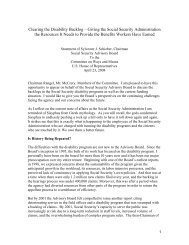Aspects of Disability Decision Making: Data and Materials
Aspects of Disability Decision Making: Data and Materials
Aspects of Disability Decision Making: Data and Materials
You also want an ePaper? Increase the reach of your titles
YUMPU automatically turns print PDFs into web optimized ePapers that Google loves.
40. Percentage <strong>of</strong> State Agency DI Awards by Basis for <strong>Decision</strong>—Fiscal Years 1975-201080%70%60%50%40%30%20%10%0%19751980198519901995200020052010Meets Listing Equals Listing Vocational ConsiderationsSince 1983, the percentage <strong>of</strong> initial level DI cases awarded on the basis <strong>of</strong> meeting the medical listingshas declined from 72 percent to 38 percent, while the percentage <strong>of</strong> cases awarded on the basis <strong>of</strong> equalingthe listings has remained relatively flat. The percentage based on vocational (or functional) evaluation hastripled, from 18 percent <strong>of</strong> all initial DI awards in 1983 to 54 percent in 2010. This increase correspondsto an increase in the number <strong>of</strong> DI cases where musculoskeletal <strong>and</strong> mental impairments were alleged<strong>and</strong> vocational evaluations are more likely to be required for these cases. Further, there were many policychanges in the 1980s stemming from court cases <strong>and</strong> legislation that directly affected how decision makersassessed functional capacity (See pages 91–93).<strong>Aspects</strong> <strong>of</strong> <strong>Disability</strong> <strong>Decision</strong> <strong>Making</strong>: <strong>Data</strong> <strong>and</strong> <strong>Materials</strong> 45









